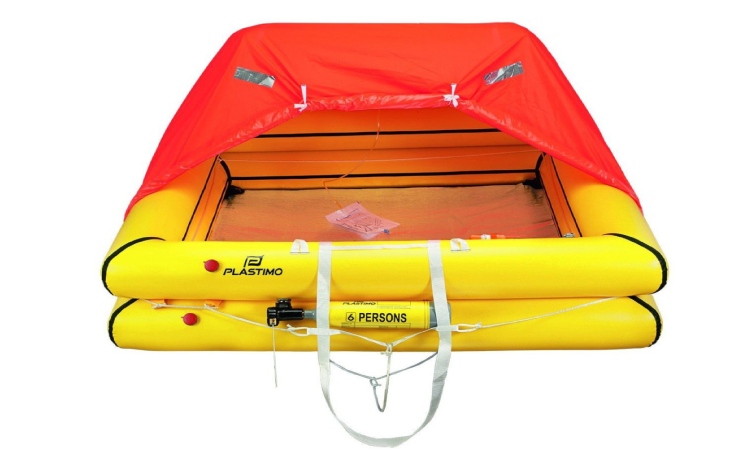When the boats are driven into the expansive sea areas, safety is always the primary element. Among the indispensable secure equipment in marine environments, an inflatable safety raft is essential for surviving. You can enhance safety and preparedness on the sea by getting to know about the functions and procedures in the summary of the user guide.
Key Components of an Inflatable Life Raft

To crucial components of inflatable lifeboats, each of the element can protect security and survival in emergencies.
Inflation Mechanism: There is a crucial component in inflatable life rafts, and that is the inflation mechanism. It can deploy quickly in emergencies. Typically, it includes the usage of manual inflation using a CO2 cylinder, and that ensures rapid inflation when in emergencies. Automatic inflation mechanisms start after the water logging. Also, they can provide extra security. Even if there is no method for passengers to operate manually, they can still guarantee the inflation of emergency inflatable rafts successfully.
Buoyancy Tubes: Buoyancy tubes are integral to the design of an inflatable life raft, offering the necessary flotation to keep the raft afloat and stable, even in turbulent waters. These tubes are carefully engineered to provide sufficient buoyancy to support the weight of occupants and any additional gear or supplies, ensuring the raft remains buoyant and upright in challenging conditions.
Canopy: The canopy of an inflatable life raft serves as a crucial element for protecting occupants from harsh environmental conditions. Designed to shield individuals from sun exposure, wind, rain, and other elements, the canopy enhances comfort and safety within the raft. Moreover, the canopy increases visibility for rescuers, making it easier for search and rescue teams to locate the raft in open waters or adverse weather conditions.
Boarding Ladder: A boarding ladder is a fundamental equipment in the emergency inflatable raft. It is helpful for embarking on the life raft safely and efficiently in terrible sea areas or wet circumstances. The life rafts are equipped with solid pedals and handrails to lower the accidents and risks during boarding to the maximum for keeping the passengers’ security. This component is essential and enhances the capacity of preparation and handling.
Using an Inflatable Life Raft: A Step-by-Step Guide

When being in emergencies and wanting to use the inflatable life raft, systematic methods can ensure a secure and effective deployment. Some detailed steps are as follows:
Deployment: In a crisis, promptly release the life raft from its storage container. Ensure that the deployment is smooth and that the raft is free from any entanglements or obstructions that could impede its inflation.
Inflation: Following the manufacturer’s instructions, activate the inflation mechanism without delay. Monitor the inflation process closely to confirm that the raft is fully inflating and that the buoyancy tubes are adequately firm. Verify that all components are functioning correctly to ensure the raft’s stability on the water surface.
Boarding: When using the boarding ladders, people should get on the rafts carefully and safely. They need to distribute the average weight among the passengers. In that case, they can keep the stability of rafts and prevent tilting or capsizing in any form. Especially in terrible weather conditions or bad marine environments, people need to pay more attention to avoid accidents.
Secure: Once inside the raft, promptly secure any loose items to prevent them from becoming hazards or causing discomfort. Close the canopy securely to shield occupants from the elements, providing protection against sun exposure, wind, and rain. Ensure that the canopy is properly sealed to maintain a safe and sheltered environment within the raft.
Addressing Incomplete Inflation of the Raft

In emergencies, if the inflatable lifeboat doesn’t acquire enough inflation, we need to take action to solve it instantly. Once the situation happens, here are several steps you can think about:
Troubleshooting Steps:
Check for Obstructions: Ensure that there are no obstructions hindering the inflation process. Clear any debris or objects that might be impeding the inflation of the raft.
Inspect Inflation Mechanism: Examine the inflation mechanism, such as the CO2 cylinder or automatic trigger, to ensure it is functioning correctly. Verify that all connections are secure and that there are no leaks or blockages.
Attempt Re-Inflation: If the raft has not fully inflated, attempt to reinflate it following the manufacturer’s instructions. Activate the inflation mechanism again and monitor the inflation process closely to see if the raft inflates properly this time.
Manual Inflation: If the automatic inflation mechanism fails, consider manually inflating the raft using the backup manual inflation option, such as a hand pump or secondary CO2 cylinder, if available.
Seek Assistance: If you are unable to resolve the issue and the raft remains underinflated, consider signaling for help. Use distress signals, such as flares or a VHF radio, to alert nearby vessels or rescuers of your situation.
Common Reasons for Inflatable Life Raft Inflation Failure
There are multiple factors that may lead to the inflation failure of inflatable safety rafts. Some common reasons include:
Obstructions: Debris or objects blocking the inflation ports can prevent proper inflation.
Mechanical Failure: Issues with the inflation mechanism, such as a faulty CO2 cylinder, can lead to incomplete inflation.
Leaks: Air leaks in the raft’s tubes or valves can result in inadequate inflation.
Improper Storage: If the raft was not stored correctly or if components were damaged during storage, inflation failure may occur.
Damage: The damage to materials, seams, and components will prevent the process of inflation.
Expired Components: Expired or degraded CO2 cylinders or inflation devices may not function as intended.
Freezing Temperatures: Extremely cold temperatures can affect the functionality of inflation mechanisms.
Improper Maintenance: Lack of regular maintenance, inspection, and testing can contribute to inflation failures.






